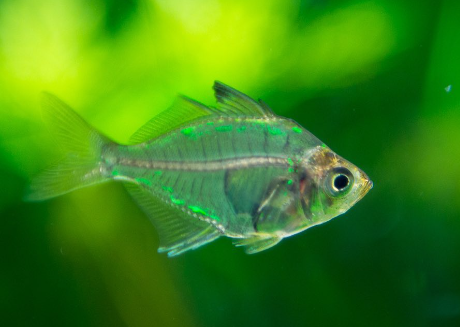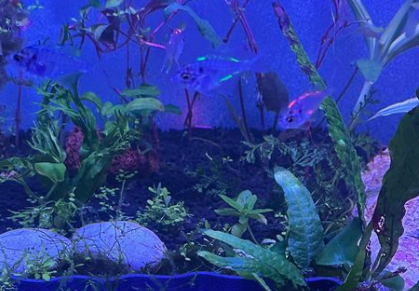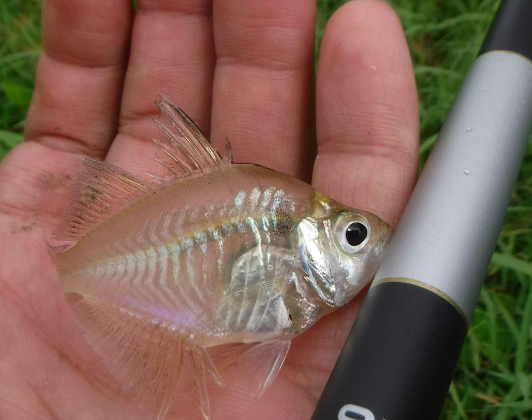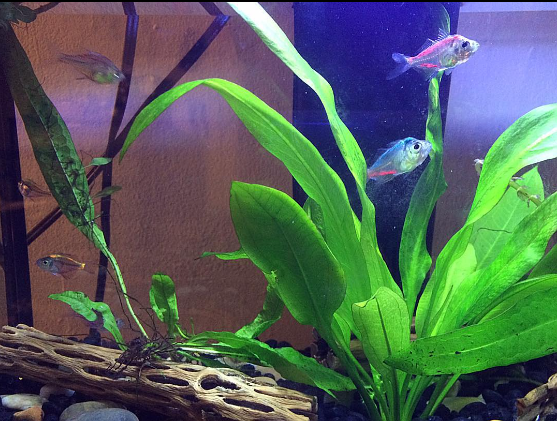Indian glassfish Care: Tank Size, Lifespan, Food & More
This post contains affiliate links. As an Amazon Associate, we earn from qualifying purchases.
Indian Glassfish, also known as the Indian glassy fish, is a popular freshwater aquarium fish species that is native to the rivers and lakes of India. Its scientific name is Parambassis ranga, and it belongs to the family Ambassidae. With its transparent body and silver coloration, the Indian Glassfish is an attractive addition to aquariums and is sought after by fish enthusiasts.
In the wild, Indian Glassfish can be found in various water bodies across India, including the Ganges, Brahmaputra, and Mahanadi river systems. They are typically found in slow-moving or standing water with abundant vegetation. In their natural habitat, these fish are known to be quite adaptable and can thrive in a range of water conditions.
| Attribute | Information |
|---|---|
| Scientific Name | Parambassis ranga |
| Common Name | Indian Glassfish, Glass Perch, Indian X-ray Fish |
| Family | Chandidae |
| Usual Size in Fish Tanks | 2 – 4 inches |
| Recommended pH Range | 6.0 – 7.5 |
| Recommended Water Hardness | 5 – 20 dGH |
| Recommended Temperature | 72°F – 82°F (22°C – 28°C) |
| Reproduction | Egg layers, scatterers |
| Origin | India, Southeast Asia |
| Temperament to Its Own Species | Peaceful and non-aggressive |
| Temperament Toward Other Fish Species | Peaceful and compatible with small, non-aggressive fish |
| Usual Place in the Tank | Middle to top water column |
| Lifespan | 3 – 5 years |
| Tank Size Requirement | Minimum 20 gallons |
| Filtration System | Canister or sponge filter recommended |
| Sexual Dimorphism | Females are generally larger and fuller-bodied |
| Substrate Cleaning | Regular vacuuming to remove uneaten food and debris |
Scientific Name
The Indian glassfish, known for its nearly transparent body, bears the scientific name Parambassis ranga. It resides under the Ambassidae family tree, which is distinct from the Percidae family that houses the true perches. This captivating species was once referred to as Chanda ranga but has since been reclassified within the Parambassis genus, embodying a unique charm in freshwater ecosystems.
Average Size
Indian glassfish, or Parambassis ranga, are small yet alluring residents of the freshwater and brackish water habitats they call home. Typically, they grow to an average length of 2.5 to 4 inches (6-10 cm), ensuring they remain manageable for most aquarium enthusiasts. What’s intriguing about this species is the modest variance in size between the sexes, with adult females often slightly outpacing the males in growth, culminating in a maximum length near the 4-inch (10 cm) mark.
Table: Indian Glassfish Size Overview
| Description | Size Range | Note |
|---|---|---|
| Average Length | 2.5 to 4 inches | Adult size |
| Maximum Length | ~4 inches | Typically seen in mature females |
| Size Comparison | Small | Manageable for aquarium enthusiasts |
| Visual Impact | Transparent Body | Adds graceful elegance to tank environments |
Remember, while their size makes them perfect companions for freshwater tanks, the Indian glassfish’s environment should be spacious enough to accommodate their schooling nature and spirited swimming behaviors.
Lifespan
The ethereal Indian glassfish is not just a marvel to behold but also a relatively enduring species in the right conditions, with a typical lifespan of 5-6 years in captivity. The secret to actualizing their full lifespan is attentive care, which hinges on three core elements: diet, water quality, and a serene environment.
Stress, often spawned by overcrowding or the presence of aggressive fish species in the same tank, can drastically shorten these glassy perches’ lives. Therefore, ensuring a tranquil and roomy habitat is paramount. Keeping their water pristine by maintaining optimal water temperature and cleanliness wards off stress and disease. Likewise, a balanced diet that includes brine shrimp and frozen foods contributes to their well-being and longevity.
To track and provide the best conditions for your Indian glass perch, consider regular monitoring and the following care guidelines:
Table: Lifespan Maximization for Indian Glassfish
| Factor | Recommendation | Impact on Lifespan |
|---|---|---|
| Water Quality | Regular monitoring and upkeep | Extends lifespan |
| Diet | Diverse, including live foods | Promotes health |
| Stress Prevention | Avoid aggressive tank mates | Prevents diseases |
| Environment | Spacious, dark substrate | Encourages natural behavior |
| Health Oversight | Timely response to issues | Reduces fatalities |
By embracing these guidelines, aquarists can nurture their Indian glassfish through a robust, joy-filled life that spans up to half a decade or more.
Natural Habitat
The Indian Glass Fish, a unique spectacle of nature’s design, thrives across South Asia, especially in the tranquil waters of India, Bangladesh, and Nepal. Found in the gentle flow of rivers, streams, and ponds, they are creatures of serenity, favoring regions rich with dense underwater forestry — a mosaic of lush vegetation and submerged roots.
In their natural retreat, these glassy fish find sanctuary among the shelter of aquatic plants and hidden crevices. Their environment varies, stretching from brackish lowland rivers to highland water bodies sitting 700 to 1000 meters above the sea. Here, the Indian Glassfish harness their transparent bodies as a natural camouflage, merging seamlessly with the watery tapestry of their habitat.
Even more, these glassy perches are accustomed to the dim light of their domains, which mirrors the shadowed zones they naturally select—estuaries, marshes, and vegetative enclaves within lakes and streams. It’s within these sheltered, plant-abundant areas that they not only hide from predators but also find ample sustenance.
Table: Indian Glass Fish Natural Habitat Overview
| Environment Feature | Details |
|---|---|
| Geographic Range | India, Bangladesh, Nepal |
| Water Type | Freshwater rivers, streams, ponds |
| Salinity | Brackish in lowlands |
| Elevation Range | 700-1000 meters above sea level |
| Light Conditions | Low-light, adapted to shade |
| Vegetation | Dense, submerged with plenty of hiding spots |
Appearance
The Indian Glass Fish captivates onlookers with its remarkable translucent body, showcasing the very inner workings of its organs—a feature that has earned them an avid following among aquarium enthusiasts. Formally known as Parambassis ranga, the species emanates a radiant sheen, its silver or golden hues contributing to an overall impression of delicate opulence. With aesthetics reminiscent of flowing ribbons, their elongated fins add to their poised and spectral demeanor.
This glassy perch is also a master of disguise, capable of subtly altering its body color to blend with its surroundings, making it a natural at playing hide and seek in the wild. Such an attribute augments their survival by providing a cunning camouflage from predators. Their slender and transparent physique offers more than mere beauty; it weaves an almost otherworldly ambiance into the aquatic tableau of any tank.
Bullet Points: Key Features of Indian Glassfish Appearance
- Transparent body showcasing internal organs
- Shiny silver or gold coloration
- Ribbon-like look with elongated fins
- Ability to adapt body coloration for camouflage
- Slender, ethereal presence enhancing aquarium aesthetic

Behavior & Temperament
Indian glassfish, known for their serene presence and graceful swimming in the tranquil waters of a home aquarium, are as peaceful in temperament as they are unique in appearance. These gentle swimmers are highly sought after by aquarists for their calm and non-aggressive nature.

Are Indian glassfish Fin Nippers?
No, Indian glassfish are not considered to be fin nippers. In a community tank, they exhibit a harmonious demeanor, gliding alongside their fellow inhabitants without ruffling any fins. They are well-known for being model citizens within the aquarium world, largely avoiding acts of aggression such as territorial behavior or fin nipping. This makes them an excellent choice for aquarists looking to create a peaceful underwater community.
Are Indian glassfish Aggressive To Each Other & Other Fish?
Indian glassfish are quite the pacifists, both among their own kind and when interacting with other species. They enjoy the company of their schoolmates and prefer not to engage in aggressive behavior. Typically, they are the ones to shy away from conflict and may become the target of more dominant fish if not appropriately matched with tank mates. It’s rare to observe aggression from these glassy perch, except perhaps during the excitement of breeding, but even then, they are more inclined to flaunt rather than fight.
Are Indian glassfish Friendly To Each Other & Other Fish?
Friendliness is a hallmark trait of the Indian glassfish. They thrive in the company of their own species, displaying communal behavior that highlights their preference for schooling in groups. Given the right companions, such as the placid bumblebee gobies, Indian glassfish will extend their congenial nature to other species. Keeping them with compatible, peaceful tank mates ensures a cohesive and stress-free environment for all the aquarium’s inhabitants.
Are Indian glassfish Schooling Fish?
Indian glassfish are indeed schooling fish, exhibiting an intrinsic behavioral trait to form groups, especially in numbers of five or more. In such schools, glassfish can be seen fluttering through the water column with synchronicity and confidence. This group dynamic not only ensures a reduction in stress but also amplifies the mesmerizing visual effect that draws so many enthusiasts to these aquatic marvels.
Can You Have Just One Indian glassfish In The Tank?
While it is possible to maintain just one Indian glassfish in a tank, it is not a scenario that caters to the natural inclinations of the species. A solitary glassfish may retreat into the shadows, overcome by shyness, and could even succumb to stress-induced health issues. Social interaction within a school is vital for their wellbeing, making a single-specimen setup far from ideal for these gregarious beings.
Do Indian glassfish Need To Be In Groups?
A resounding yes—Indian glassfish not only need but also flourish when grouped together. Their sociable nature comes to the forefront in a school, where the interplay of light through their translucent bodies brings a dynamic energy to the aquarium.
Individual stress is minimized, and their collective vibrancy is showcased, underscoring the importance of providing an environment that echoes the comfort and security of their natural habitat. To truly appreciate the splendor and content temperament of Indian glassfish, an aquarist would be well-advised to foster their communal lifestyle with an appropriately sized school.
Food & Diet
The Indian glassfish (Parambassis ranga) is recognized for its unique transparent body and is native to the freshwater and brackish water habitats of South Asia. An integral part of caring for these captivating fish is understanding their dietary requirements to maintain their health and vitality.

Do Indian glassfish Eat Algae?
While Indian glassfish are considered omnivorous, algae is not a significant part of their diet. In their natural environment, they may consume algae incidentally, but they tend to favor a carnivorous diet. In captivity, it’s advisable to supplement their diet with prepared algae-based foods to provide essential nutrients. Including algae in their diet can contribute to a balanced nutritional intake but should not be the sole food source.
Do Indian glassfish Eat Shrimp?
Shrimp, such as brine shrimp, bloodworms, and mosquito larvae, are a nutritional powerhouse for Indian glassfish, offering rich proteins and vital nutrients that align with their predatory nature. These fish show a pronounced inclination towards hunting and consuming small live foods like shrimp, which promotes natural foraging behavior and is beneficial for their health.
Do Indian glassfish Eat Bloodworms?
Bloodworms are undoubtedly a hit with Indian glassfish. These worms are not just a treat; they’re a core component of their diet, providing high protein content that supports growth and color vibrancy. Aquarists can feed Indian glassfish bloodworms either live or frozen to satisfy their carnivorous appetite and enhance their well-being.
Do Indian glassfish Eat Mosquito Larvae?
Indian glassfish are adept hunters that find mosquito larvae to be a particularly appetizing meal. These larvae offer a nutrient-rich diet, serving as an excellent source of protein. Indulging in mosquito larvae will mimic the Indian glassfish’s predatory behaviors in the wild and assist in maintaining their energetic and healthy nature.
Do Indian glassfish Eat Planaria?
In an aquarium setting, Indian glassfish may contribute to the balance of the ecosystem by consuming small, available invertebrates such as planaria. While they can eat these flatworms, planaria should not be a staple in their diet. To guarantee a well-rounded diet, a mix of live, frozen, and occasional dry foods is recommended.
Do Indian glassfish Eat Plants?
Indian glassfish lean towards a carnivorous diet, and although they may accidentally ingest plant fragments, they do not consume plants as a noteworthy portion of their diet. They thrive on a diverse diet of animal-based proteins, reflective of their natural feeding habits.
Plant matter is not their preferred choice, and their digestive systems are more suited for processing meats like small invertebrates and insects. Fishkeepers should focus on feeding practices that mimic the glassfish’s natural dietary behaviors for the best results in their care and longevity.

Sexing: Male vs Female
Indian glassfish reach sexual maturity at around six months, and telling the males apart from the females becomes more noticeable due to clear sexual dimorphism. Male Indian glassfish develop an attractive golden hue with their distinctive fins edged in a vibrant blue. In contrast, females have more subtle coloration, presenting a silvery-yellow tint and lack the striking blue fin edges seen in males.
The physical differences are further accentuated in the body shape and internal structures. Males boast a more angular air-bladder that is sharp in appearance, setting them apart from their female counterparts. Additionally, females exhibit a rounder and slightly bulkier abdomen, often due to egg carrying.
Sexing the Indian glassfish is also more straightforward when observing fin coloration. Males have blue-edged fins, whereas females have entirely clear fins. These visual cues are reliable indicators for sexing these unique aquarium dwellers.
Providing proper diet and maintaining optimal environmental conditions are crucial as they can greatly affect the appearance and health of adult fish, influencing the ease of sex differentiation.
| Sex | Coloration | Fins | Body Shape |
|---|---|---|---|
| Male | Golden with bright-blue fins | Blue-edged fins | Sharpened air-bladder |
| Female | Silvery-yellow | Clear fins | Larger abdomen, rounder shape |
Indian glassfish Tank Mates
Indian glassfish are gregarious and thrive when kept in schools of at least 5, enjoying the serenity of fellow non-aggressive tank mates. In freshwater environments, ideal companions include the likes of playful guppies, vibrant tetras, colorful rainbowfish, peaceful corys, and soothing loaches. For those preferring brackish conditions, accommodating mollies and friendly bumblebee gobies alongside your glassy perch creates a harmonious aquatic tapestry.
Selecting tank mates requires consideration of size and temperament; a delicate equilibrium that maintains the stress-free existence of these transparent gems. Similitude in activity levels is equally paramount, ensuring a cohesive community where the glassfish can bask in their natural schooling instincts. Peaceful yet timid, the Indian glassfish’s well-being is preserved when sharing their liquid realm with calm species, mirroring their water parameter preferences.
| Habitat | Appropriate Tank Mates |
|---|---|
| Freshwater | Guppies, Tetras, Rainbowfish, Corys, Loaches |
| Brackish | Mollies, Bumblebee Gobies |
In sum, a tranquil environment fostered by like-minded aquatic residents enhances the Indian glassfish’s spirited nature.
- Keep Indian glassfish in groups (min. 5)
- Choose peaceful, similarly sized tank mates
- Match activity levels for a stress-free community
Aquarium Setup
Creating a home for Indian glassfish is not just about filling a tank with water and placing the fish inside; it requires careful consideration and planning. A setup that closely replicates their natural habitat will ensure these aquatic wonders remain healthy and vibrant.
Ideal Tank Size
The Indian glassfish, with its schooling nature and active swimming behavior, demands sufficient space to thrive. For a single specimen, a 15-gallon tank is the absolute minimum to consider, but since these are social creatures that prefer to be in groups, a larger tank is necessary.
A setup of at least 30 gallons is recommended when hosting a school of at least five glassfish to provide enough room for each individual to swim and exhibit natural behaviors. This ensures that they do not feel cramped, which can lead to stress and health problems.
Ideal Water Parameters
Indian glassfish are quite hardy and adapt well to various water conditions, but they do best in a well-maintained environment. They thrive in slightly soft to moderately hard water with a degree of general hardness (dGH) ranging from 7 to 19.
The pH levels should be maintained between 6.5 and 7.5, ideally within a slightly acidic to neutral range. These parameters mimic their natural freshwaters in South Asia, allowing the glassfish to maintain their health and lively demeanor.
As for temperature, Indian glassfish appreciate a warm tropical range between 68–86 °F (20–30 °C). It is essential to monitor these parameters regularly to spot any deviations and act accordingly to correct them.
Filtration
A robust filtration system is critical in the aquarium of Indian glassfish. Given their sensitivity to the build-up of harmful byproducts like ammonia and nitrite, quality filtration keeps the water pristine and health-supportive.
Canister filters often serve as an excellent choice for Indian glassfish tanks due to their efficiency in removing waste and their ability to maintain stable water parameters.
Lighting
Proper lighting is an often overlooked but crucial aspect of the Indian glassfish aquarium setup. These fish hail from environments that offer shelter from direct sunlight, so they are accustomed to more subdued lighting conditions. A combination of shaded areas provided by floating plants and adjustable LED lighting ensures that the glassfish enjoy a habitat that feels natural and secure.
Implementing a timer can maintain a consistent cycle of light and dark, simulating the normal diurnal patterns their bodies are programmed to follow. This lighting arrangement will not only benefit the Indian glassfish but also encourage the growth of live plants, enhancing the overall aesthetics of the aquarium.
| Parameter | Ideal Conditions for Indian Glassfish |
|---|---|
| Tank Size | 30+ gallons for a group of 5 |
| Water Hardness | 7–19 dGH |
| pH Levels | 6.5–7.5 |
| Temperature | 68–86 °F (20–30 °C) |
| Filtration | Effective canister filter |
| Lighting | Subdued, adjustable LED; natural cycle |
Common Possible Diseases & Prevention
Glassfish are native to India and are known for their stunning appearance and peaceful nature. They are often found in the freshwaters of rivers, lakes, and streams throughout the region. The Indian Glassfish, also known as the Indian flying barb or the Indian glassy fish, is a popular choice for aquarium enthusiasts due to its transparent body and shimmering scales.
The Indian Glassfish is a relatively small fish, typically reaching a maximum length of around 3 inches. Its most distinctive feature is its transparent body, which makes it appear almost invisible in the water. When illuminated, the fish’s scales take on a beautiful iridescent quality, making it a striking addition to any aquarium.
In their natural habitat, Indian Glassfish are known to be peaceful and social creatures, often found in schools as they swim gracefully through the water. In an aquarium setting, they thrive in a well-planted environment with plenty of open space for swimming. They are relatively easy to care for and can adapt well to a variety of water conditions.
It’s important to note that Indian Glassfish are a shoaling species, meaning they should ideally be kept in groups of six or more. This helps to reduce stress and can encourage more natural behavior in the fish. They are generally peaceful and can be housed with other peaceful species that are not large enough to prey on them.
Health Concerns of Dyed Indian Glassfish
Indian glassfish are inherently captivating due to their naturally transparent bodies. However, the practice of injecting them with fluorescent dyes breeds severe health implications. Such alterations predispose these glassy fish to infections like ich, a parasite-induced illness, and fin rot—both of which can significantly impact their well-being.
Lymphocystis: An Incurable Affliction
Of particular concern is Lymphocystis, a viral disease that etches white cysts upon their fins and skin. Alarmingly, there is no remedy for this condition, making it vital to select undyed fish to ensure long-term health.
Avoiding Health Risks
To mitigate disease risks, always opt for fish showcasing their inherent transparency. The presence of unnatural neon stripes or dots is a telltale sign of dye injections, which severely reduce the fish’s lifespan and resistance to health issues. Steering clear of dyed specimens is a crucial preventative measure, safeguarding against a spectrum of potential infections.
| Do’s and Don’ts for Disease Prevention |
|---|
| ✓ Only purchase glassfish with untainted bodies |
| ✘ Avoid fish with artificial coloring (stripes/dots) |
| ✓ Conduct pre-purchase health checks |
| ✘ Refrain from buying fluorescent dyed fish |
Breeding Indian glassfish In Aquarium
Successfully breeding Indian glassfish requires setting up a dedicated breeding tank, preferably within the 20 to 40-liter range. The water pH should be maintained at or above 7.5, as this is crucial for the proper development of the fry. One should densely populate the tank with moss, such as Java moss, to facilitate egg laying.
To initiate spawning, one male and two females should be introduced to the breeding tank. Feeding them live prey like artemia or mud worms, coupled with a gradual increase in water temperature to 28-29°C (82-84°F), induces spawning.
Post-spawning, it’s imperative to remove the adult fish to protect up to 500 delicate eggs, averting potential parental predation. To combat fungal threats to the eggs, apply Trypaflavin at a concentration of 1g per 100 liters. Expect eggs to hatch within 24 hours, with the fry becoming free swimming after 4 to 5 days. At this stage, feed the fry with shellfish nauplias like artemia or cyclops.
| Breeding Stage | Environment Parameters / Actions |
|---|---|
| Setting up | 20-40L tank, pH ≥ 7.5, densely planted with moss |
| Spawning | 1 male and 2 females, live prey diet, increase temperature |
| Post-egg laying | Remove adults fish, add Trypaflavin to prevent fungi |
| Hatching and Development | 24-hour incubation, 4-5 days to free swimming, start feeding fry |
Essential steps and care can lead to a vibrant school of transparent Indian glassfish thriving in your aquarium.
Are Indian glassfish Easy To Keep?
Indian glassfish, known scientifically as Parambassis ranga, are often touted for their moderateness in care level, lending themselves well to the dedicated aquarist’s tank. Despite lingering myths suggesting a brackish habitat is necessary for their well-being, these gleaming fish are actually quite adaptable to freshwater environments with proper care.
To maintain a group of Indian glassfish comfortably, a minimum shoal of 5 is ideal, reflecting their preference for social living and encouraging their innate behavior. Housing them in an environment that mirrors their natural habitat increases their ease of care. The ideal water parameters for this species are a pH range between 6.5-7.5 and a water temperature spectrum of 68°-86°F, accommodations that craft a healthy habitat and contribute to their resilience.
Are Indian glassfish Sensitive To Water Changes?
Indeed, Indian glassfish manifest a sensitivity to abrupt water parameter alterations, including temperature, pH, and hardness. Such rapid shifts can induce stress, compromising their immune system and heightening disease vulnerability. Extreme attention should be devoted to maintaining a consistent aquarium environment, as fluctuations in ammonia and nitrite can be especially harmful, manifesting as stress and potentially leading to mortality.
Are Indian glassfish Sensitive To Ammonia?
The Indian glassfish’s health is severely threatened by elevated ammonia levels within their tank. Ammonia, which arises from organic waste decomposition, if not managed, can induce a variety of symptoms, from the subtlety of increased gill movement to the more overt signs such as lethargy and surface gasping. More insidious still, ammonia can damage the delicate gill tissues, inhibiting their ability to respire and process waste effectively.
Are Indian glassfish Sensitive To Copper?
Copper sensitivity is another significant concern for Indian glassfish, as even minute traces of this heavy metal can be fatal. Exposure to copper, which can be found in certain medications, through copper plumbing, or in some water sources, can result in respiratory hardships and eventually lead to mortality.






